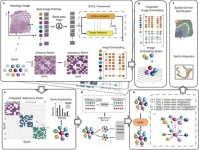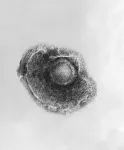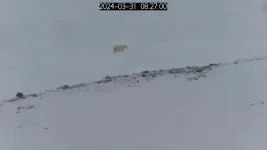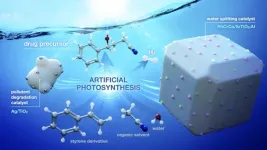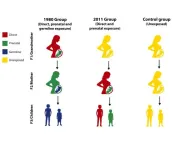(Press-News.org) New University of Sheffield research shows that combining solar panels with farming (agrivoltaics) can meet UK solar energy targets without sacrificing agricultural land
The coverage potential for the technology is so high that it could meet UK electricity demand more than four times over
Regions identified for the effective deployment of agrivoltaics include Cambridgeshire, Essex, Lincolnshire, and the broader East and South East of England
The approach counters criticism of traditional solar farms, which are often opposed due to concerns about lost farmland, food production and visual impact
Previous studies in Tanzania and Kenya have shown that agrivoltaics not only generates clean energy but can also boost crop yields and conserve water
Ambitious government plans for the expansion of solar farms could be achieved without sacrificing farmland, according to new research on a technology that could meet the UK’s electricity needs four times over.
The University of Sheffield study assessed how agrivoltaics technology - integrating solar panels into farmland in a way that maintains agricultural activities - could help the UK reach its solar energy targets (PV) and meet its commitment to reach net zero by 2050.
Current government plans to significantly increase ground-mounted solar parks, which are already in use across the UK, have proven contentious and unpopular with farmers and the public alike. Concerns about the loss of high-quality agricultural land, potential impacts on food production and cost of living, and the visual impact on landscapes are among factors fuelling the criticism.
The Great Britain-focussed study demonstrates that the deployment of agrivoltaics, which would see solar photovoltaic panels installed in ways to allow for farming activities underneath or between panels, could enable the simultaneous production of crops, livestock and renewable energy. Agrivoltaics has such high coverage potential that it could meet UK government PV targets on its own, while avoiding land use conflicts.
Professor Sue Hartley, Vice-President for Research and Innovation at the University of Sheffield who co-authored the study, said: “The Government and solar developers have ambitious plans for the expansion of solar farms but these risk the loss of agricultural land needed for food production at a time when global food security is threatened by geopolitical uncertainty and climate change.
“Agrivoltaic technology is a potential way out of this dilemma. It allows us to use the same area of land for both food and clean energy production, addressing some of the criticism levelled at solar farms. This technology is in regular use in many areas of the world, including areas like Scandinavia with less sunlight than the UK, but has not yet been adopted here.
“Our research identifies the areas in the UK where this technology can be most effectively deployed, both to mitigate land use conflicts and deliver the UK’s energy needs.”
Regions identified for the effective deployment of agrivoltaics include Cambridgeshire, Essex, Lincolnshire, and the broader East and South East of England. Several factors contribute to this suitability, including the availability of flat land, the extent of existing agricultural use, grid connectivity and the prevalence of solar radiation.
A £1.4 million research project led by the University of Sheffield previously saw agrivoltaic systems installed on farmland in Tanzania and Kenya. Not only did the technology produce low carbon electricity, it was found to significantly boost crop yields and conserve water in regions that are acutely vulnerable to the impacts of climate change. Researchers found that certain crops, such as maize, Swiss chard and beans, thrived under the partial shade provided by solar panels. The shade offered further benefits: it reduced water evaporation for more efficient water use and the panels themselves provided rainwater to supplement irrigation needs.
The new study on the technology’s UK potential aims to inform land use policy debates by promoting multifunctional land use and encouraging more research to support and guide the development of domestic agrivoltaics.
Co-author Dr Richard Randle-Boggis, who conducted agrivoltaics research at the University of Sheffield and is now a research scientist at SINTEF, said: “Research on agrivoltaics is extensive in mainland Europe, but very little has been done in the UK.
“Our next step should be field experiments to test the performance of the systems, investigate different designs with different crops and better understand the perspectives of local communities and other stakeholders.
“The loss of farmland is typically a major reason communities oppose solar park development in their local areas. Our research takes a leading step in demonstrating where solar parks could be developed alongside agricultural activities so that farmland is not lost.”
The study, co-authored by Talitha Neesham-McTiernan, Alastair Buckley and Sue Hartley from the University of Sheffield and Richard Randle-Boggis from SINTEF, is available in the Science Direct journal.
END
Solar technology could meet UK’s electricity needs without sacrificing farmland
2025-02-27
ELSE PRESS RELEASES FROM THIS DATE:
Study finds aged biomass emissions could pose greater risk to lungs than fresh wildfire smoke
2025-02-27
Biomass burning—whether from wildfires, wood stoves or agricultural fires—sends massive amounts of tiny particles and chemicals into the air. These emissions are not just an environmental issue; they pose serious health risks, especially for our lungs. An Environmental Pollution study, co-authored by Dr. Jason Surratt, a professor in the Department of Chemistry at UNC-Chapel Hill, reveals how two key components of biomass smoke—levoglucosan and 4-nitrocatechol—affect human lung cells. Their findings suggest that aged ...
Four research teams rethink particleboard construction and reuse
2025-02-27
For a few hundred dollars, a bedroom can be refreshed with the latest flat-pack offerings. Wood particleboard furniture is affordable and generally easy to assemble, but particleboard is often held together with formaldehyde-based resins that make it hard or impossible to recycle. Now, with the help of science, old pressed-wood furnishings could be repurposed, and new modular decor could incorporate more environmentally friendly materials. Four articles published in ACS journals reveal how. Reporters can request free access to these papers ...
Deep-learning framework advances tissue analysis in spatial transcriptomics
2025-02-27
Biological tissues are made up of different cell types arranged in specific patterns, which are essential to their proper functioning. Understanding these spatial arrangements is important when studying how cells interact and respond to changes in their environment, as well as the intricacies of pathologies like cancer. Spatial transcriptomics (ST) techniques, which have been rapidly evolving over the past decade, allow scientists to map gene activity within tissues while keeping their structure intact, ...
From dormant to danger: How VZV reactivation is driving CNS infections
2025-02-27
The varicella zoster virus (VZV), an infectious virus from the herpes virus family, is primarily known to cause varicella in children and shingles in adults. But lately, this virus has also been reported to trigger severe complications like central nervous system (CNS) infections. Researchers from Fujita Health University, Japan, conducted a comprehensive study spanning 10 years (2013–2022), to identify the VZV-related infections affecting the CNS. Their study reveals a marked increase in adult VZV-related CNS infections, ...
DNA barcodes narrow down possible sources of introductions of an invasive banana skipper butterfly pest
2025-02-27
CABI has led a team of scientists who have used DNA barcodes to narrow down the possible sources of introductions of an invasive banana skipper butterfly, with implications as to the threat of it spreading to Africa and tropical America.
The banana skipper, Erionota torus Evans (Lepidoptera, Hesperiidae, Hesperiinae, Erionotini) is a South-east Asian pest of banana that, in the last 60 years, has spread to the southern Philippines, Taiwan, Japan, India, Sri Lanka, Mauritius and La Réunion.
The new research, published in the journal CABI Agriculture and Bioscience, analysed a partial library of DNA barcodes from the indigenous and introduced ranges and suggests that aircraft are likely ...
Transforming clinical care for children with rare genetic diseases
2025-02-27
Global partnerships that embed scientific research into clinical care are revolutionising the diagnosis and treatments for children with rare genetic diseases, according to a new report.
The white paper found despite advances in genomic technologies, which can detect rare genetic diseases within days, there remained significant challenges to ensuring this leads to improved child health outcomes. But global collaborations, such as the International Precision Child Health Partnership (IPCHiP), using evidence-based approaches to inform decisions in real-time, are overhauling patient care.
The paper was led by Murdoch Children’s Research Institute (MCRI), The Hospital for Sick ...
Polar bear cubs emerging from their dens for the first time: New study captures rare footage
2025-02-27
Svalbard, Norway – February 27, 2025 – Researchers from Polar Bears International, San Diego Zoo Wildlife Alliance, the Norwegian Polar Institute, and the University of Toronto Scarborough reveal the first detailed look at polar bear cubs emerging from their dens, captured through nearly a decade of remote camera footage in Svalbard, Norway. This research, published today on International Polar Bear Day in the Journal of Wildlife Management, marks the first combination of satellite tracking collars with remote camera traps to answer ...
Turning waste organic compound into useful pharmaceuticals and energy using a technique inspired by photosynthesis
2025-02-27
A research team led by Assistant Professor Shogo Mori and Professor Susumu Saito at Nagoya University has developed a groundbreaking method of artificial photosynthesis that uses sunlight and water to produce energy and valuable organic compounds, including pharmaceutical materials, from waste organic compounds. This achievement represents a significant step toward sustainable energy and chemical production. The findings were published in Nature Communications.
“Artificial photosynthesis involves chemical reactions ...
Violence alters human genes for generations, researchers discover
2025-02-27
In 1982, the Syrian government besieged the city of Hama, killing tens of thousands of its own citizens in sectarian violence. Four decades later, rebels used the memory of the massacre to help inspire the toppling of the Assad family that had overseen the operation.
But there is another lasting effect of the attack, hidden deep in the genes of Syrian families. The grandchildren of women who were pregnant during the siege — grandchildren who never experienced such violence themselves — nonetheless bear marks of it in their genomes. ...
Scientists discover key protein in resilience to stress
2025-02-27
When faced with chronic stress, why do some people develop anxiety and depressive symptoms while others show resilience? A protein that acts as a cannabinoid receptor and is present in the structure controlling exchanges between the bloodstream and the brain could be part of the answer, according to a study published today in Nature Neuroscience.
“The protein, called cannabinoid receptor type 1 (CB1), is part of the blood-brain barrier, the dynamic structure that protects the brain by regulating the passage of molecules between the bloodstream and ...
